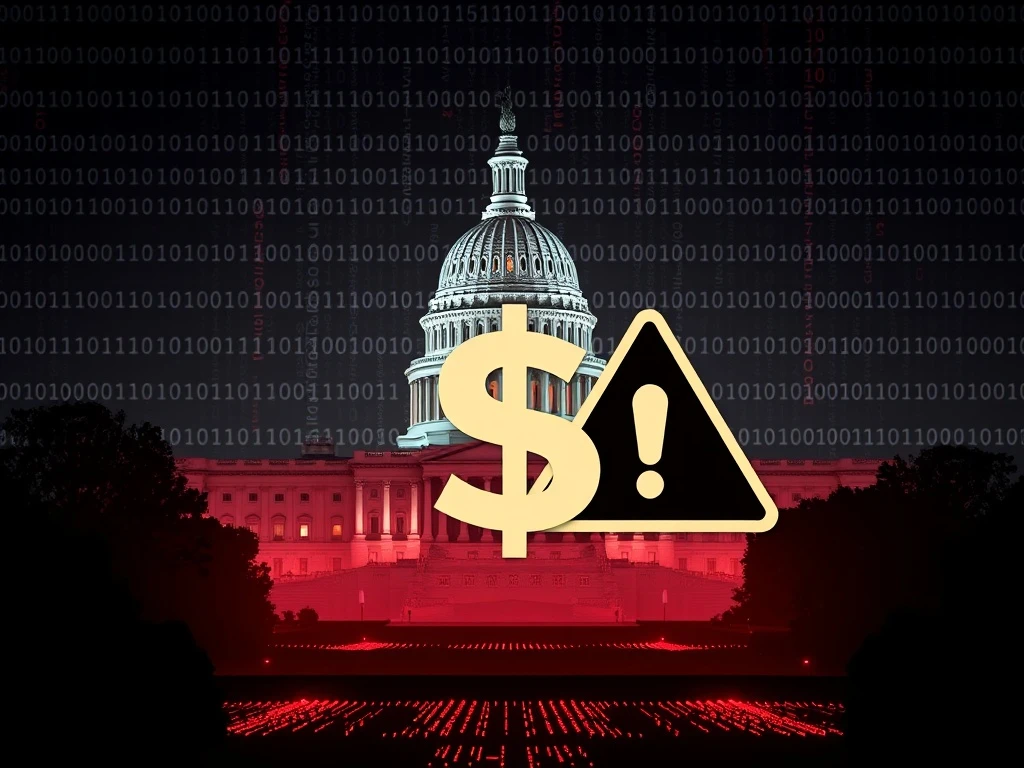Unprecedented US AI Policy: Federal Funding at Risk for States with Burdensome AI Rules

In the rapidly evolving world of technology, where advancements like AI are reshaping industries at lightning speed, government policies play a pivotal role. For those of us keenly watching the crypto and blockchain space, understanding how regulatory frameworks are established for emerging technologies like AI is crucial. A recent announcement from the U.S. government has sent ripples through the tech community, signaling a major shift in how the nation plans to manage artificial intelligence. The new **US AI Policy** threatens to withhold federal funding from states that implement AI regulations deemed “burdensome.” This move highlights a powerful push to streamline innovation and reduce bureaucratic hurdles, but it also sparks a heated debate about state autonomy and public interest.
The White House’s Bold Stance on AI Regulation
The core of this new directive stems from the White House AI Action Plan, released under President Donald Trump’s administration. This plan isn’t just a suggestion; it mandates federal agencies to actively scrutinize state AI laws. The objective? To identify and potentially penalize jurisdictions where rules could “weaken federal support” or “waste these funds.” While the plan does allow for “thoughtfully crafted legislation” that doesn’t “unduly restrict innovation,” it clearly establishes a framework where states are under immense pressure to align with federal priorities.
This isn’t an entirely new concept. We’ve seen similar legislative proposals in Congress, such as the ambitious “Big Beautiful Bill” which proposed banning state AI rules for a decade, and Senator Ted Cruz’s initiative linking federal funding to states rolling back stringent regulations. The current administration’s approach seems to consolidate these ideas into a concrete policy. Federal agencies now have the authority to evaluate state AI policies before awarding grants, with the power to reduce or even deny funds if they perceive regulatory conflicts. The Federal Communications Commission (FCC) is also tasked with assessing whether state-level AI laws infringe on its regulatory jurisdiction, adding another layer of federal oversight.
Federal Funding Under Threat: What Does This Mean for States?
The implications of this policy, particularly concerning **federal funding**, are significant. States rely heavily on federal grants for a wide array of programs, from infrastructure development to educational initiatives. The threat of losing these funds could force states to reconsider their approach to AI governance, potentially leading to a more uniform, federally-aligned regulatory landscape. But what exactly constitutes a “burdensome” rule remains a critical question.
This ambiguity has ignited concerns among legal experts and state officials alike. Grace Gedye of Consumer Reports highlighted the uncertainty over which federal funds are at risk and how states might adapt to such vague guidelines. Forrester analyst Alla Valente echoed these sentiments, noting that undefined terms like “ideological bias” and “burdensome regulations” could complicate implementation significantly. This lack of clarity could lead to:
- Increased legal disputes between states and federal agencies.
- Compliance challenges for states attempting to navigate new federal mandates.
- A potential chilling effect on states’ willingness to innovate with their own AI policies.
For states, it’s a tricky situation. They want to protect their citizens and foster responsible AI development, but they also can’t afford to jeopardize crucial federal financial support. This policy effectively creates a high-stakes balancing act.
Prioritizing Tech Innovation: A Double-Edged Sword?
One of the primary stated goals of this **US AI Policy** is to accelerate **tech innovation** by removing perceived regulatory “red tape.” The administration aims to position the U.S. as a global AI leader, and they believe that minimizing state-level restrictions is key to achieving this. This includes expediting permitting for AI data centers and semiconductor facilities, even proposing exemptions under the National Environmental Policy Act for projects with minimal environmental impact. Additionally, the policy enforces export controls on semiconductor subsystems to protect U.S. technological leadership.
While industry groups like the National Association of Manufacturers have praised these regulatory reforms, not everyone is convinced this approach is entirely beneficial. Critics, such as Sarah Myers West of the AI Now Institute, argue that the policy disproportionately favors large tech firms over public interests, stating it prioritizes “corporate interests over the needs of everyday people.” This perspective suggests that by streamlining regulations, the policy might inadvertently overlook crucial ethical safeguards and societal impacts.
Furthermore, the administration has revised the National Institute of Standards and Technology (NIST) AI Risk Management Framework, notably removing references to misinformation, climate change, and diversity, equity, and inclusion. This revision, coupled with the policy’s emphasis on ideological neutrality in AI models, has sparked further debate. Georgetown University’s Bonnie Montano cautioned that excluding contested data might conflict with the plan’s goals of fairness and inclusivity, potentially introducing new forms of bias into AI models. The balance between fostering rapid innovation and ensuring ethical, responsible AI development is a complex challenge.
The Impact on State AI Laws and Future Governance
The ramifications for **state AI laws** are profound. States that have already begun drafting or implementing their own AI regulations now face the daunting task of reinterpreting existing laws without clear federal guidelines on what constitutes “burdensome.” Mashable observed that this funding linkage creates a “lurch” for states, forcing them into a reactive position. This could lead to a patchwork of revised state laws, or perhaps, a reluctance to enact any new AI-specific legislation at all, for fear of losing federal aid.
The policy’s success hinges on balancing innovation incentives with ethical safeguards. Over 10,000 public comments shaped the plan, according to a BBC report, underscoring the contentious nature of AI regulation. As federal agencies begin implementation, stakeholders will closely monitor how states adapt and whether the administration clarifies the vague definitions for regulatory compliance. This ongoing dynamic between federal oversight and state autonomy will undoubtedly shape the future of AI governance in the U.S.
The policy’s rollout also coincides with broader international efforts by the administration, including relaxed export limits on Nvidia and AMD chips to China and infrastructure deals in Gulf countries. This suggests a multifaceted strategy to bolster the U.S.’s position in the global AI race, intertwining domestic regulatory pressures with international trade and technological leadership.
Navigating the Future of AI Governance: What’s Next?
The new **US AI Policy** represents a pivotal moment in the governance of artificial intelligence. It underscores a strong federal desire to accelerate tech innovation by reducing what it perceives as unnecessary regulatory hurdles. While proponents argue this will boost American competitiveness, critics warn of potential risks to public interests and ethical AI development. The ambiguity surrounding terms like “burdensome” and “ideological bias” creates significant challenges for states, forcing them to re-evaluate their legislative approaches to avoid jeopardizing crucial federal funding. As this policy unfolds, the tech world, from AI developers to crypto enthusiasts, will be watching closely to see how this delicate balance between innovation, regulation, and ethical considerations ultimately plays out. The clarity, or lack thereof, in the coming months will determine the true impact on the future of AI in America.
Frequently Asked Questions (FAQs)
Q1: What is the main objective of the new US AI Policy regarding states?
The primary objective is to encourage states to align their AI regulations with federal priorities by threatening to withhold federal funding from states that implement AI rules deemed “burdensome,” thereby aiming to streamline innovation and reduce bureaucratic hurdles.
Q2: What does “burdensome” AI regulation mean under this policy?
The policy does not explicitly define “burdensome,” which is a major point of contention. It generally refers to state AI laws that could “weaken federal support” or “waste these funds,” but the lack of a clear definition has raised concerns about ambiguity and potential legal disputes.
Q3: How might this policy impact states that have already developed AI laws?
States with existing AI laws may be forced to review and potentially revise their regulations to ensure compliance with the new federal guidelines. Failure to do so could result in a reduction or denial of federal grants, putting significant financial pressure on state budgets.
Q4: What are some of the criticisms of this new AI policy?
Critics argue that the policy favors large tech firms over public interests, potentially overlooks ethical safeguards, and could introduce bias by removing references to misinformation, climate change, and diversity from AI risk frameworks. The ambiguity of key terms is also a significant concern.
Q5: How does this policy aim to boost tech innovation?
The policy aims to boost tech innovation by expediting permitting for AI data centers and semiconductor facilities, including potential environmental policy exemptions, and by enforcing export controls on semiconductor subsystems to protect U.S. technological leadership. The overarching goal is to reduce perceived regulatory barriers to AI development.









